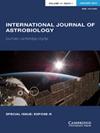Complex structures synthesized in shock processing of nucleobases – implications to the origins of life
IF 1
4区 物理与天体物理
Q3 ASTRONOMY & ASTROPHYSICS
引用次数: 2
Abstract
Nucleobases are nitrogenous bases composed of monomers that are a major constituent of RNA and DNA, which are an essential part of any cellular life on the Earth. The search for nucleobases in the interstellar medium remains a major challenge, however, the recent detection of nucleobases in meteorite samples and laboratory synthesis in simulated analogue experiments have confirmed their abiotic origin and a possible route for their delivery to the Earth. Nevertheless, cellular life is based on the interacting network of complex structures, and there is substantial lack of information on the possible routes by which such ordered structures may be formed in the prebiotic environment. In the current study, we present the evidence for the synthesis of complex structures due to shock processing of nucleobases. The nucleobases were subjected to the reflected shock temperature of 3500–7000 K (estimated) and pressure of about 15–34 bar for over ~2 ms timescale. Under such extreme thermodynamic conditions, the nucleobases sample experiences superheating and subsequent cooling. Electron microscopic studies of shock processed residue show that nucleobases result in spontaneous formation of complex structures when subjected to extreme conditions of shock. These results suggest that impact shock processes might have contributed to the self-assembly of biologically relevant structures and the origin of life.核碱基冲击加工合成的复杂结构——对生命起源的启示
碱基是由单体组成的含氮碱基,它们是RNA和DNA的主要成分,是地球上任何细胞生命的重要组成部分。在星际介质中寻找核碱基仍然是一个重大挑战,然而,最近在陨石样本中检测到的核碱基和模拟模拟实验中的实验室合成已经证实了它们的非生物起源以及它们输送到地球的可能途径。然而,细胞生命是基于复杂结构的相互作用网络,并且基本上缺乏关于在益生元环境中形成这种有序结构的可能途径的信息。在目前的研究中,我们提出了由于核碱基的冲击处理而合成复杂结构的证据。核碱基受到3500–7000 K(估计)的反射冲击温度和约15–34 bar的压力的影响,时间跨度超过2 ms。在这种极端的热力学条件下,核碱基样品经历过热和随后的冷却。冲击处理残留物的电子显微镜研究表明,当受到极端冲击条件时,核碱基会自发形成复杂结构。这些结果表明,冲击冲击过程可能有助于生物相关结构的自组装和生命的起源。
本文章由计算机程序翻译,如有差异,请以英文原文为准。
求助全文
约1分钟内获得全文
求助全文
来源期刊

International Journal of Astrobiology
地学天文-地球科学综合
CiteScore
3.70
自引率
11.80%
发文量
45
审稿时长
>12 weeks
期刊介绍:
International Journal of Astrobiology is the peer-reviewed forum for practitioners in this exciting interdisciplinary field. Coverage includes cosmic prebiotic chemistry, planetary evolution, the search for planetary systems and habitable zones, extremophile biology and experimental simulation of extraterrestrial environments, Mars as an abode of life, life detection in our solar system and beyond, the search for extraterrestrial intelligence, the history of the science of astrobiology, as well as societal and educational aspects of astrobiology. Occasionally an issue of the journal is devoted to the keynote plenary research papers from an international meeting. A notable feature of the journal is the global distribution of its authors.
 求助内容:
求助内容: 应助结果提醒方式:
应助结果提醒方式:


